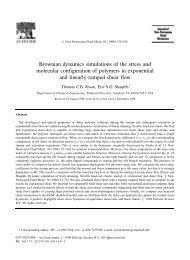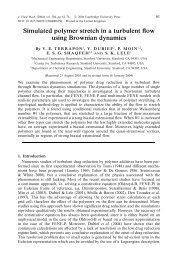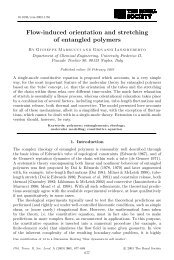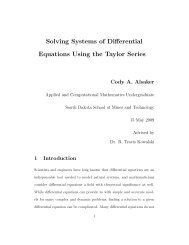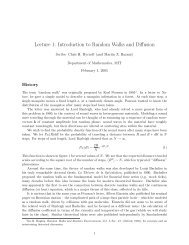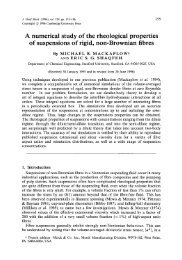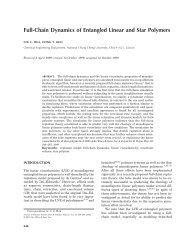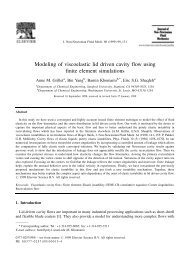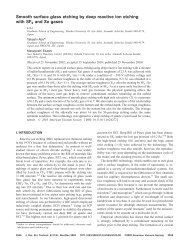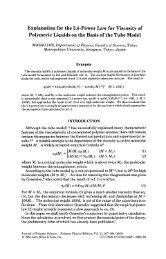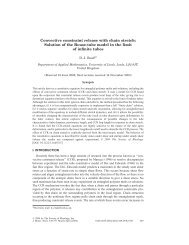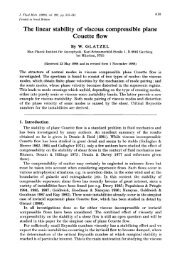Molecular modelling of entangled polymer fluids under flow The ...
Molecular modelling of entangled polymer fluids under flow The ...
Molecular modelling of entangled polymer fluids under flow The ...
Create successful ePaper yourself
Turn your PDF publications into a flip-book with our unique Google optimized e-Paper software.
2.5. BRANCHED POLYMERS 37<br />
From this calculation an exponential dependence <strong>of</strong> the segment relaxation time on<br />
distance from the free end is obtained. This calculation is insufficient to reproduce<br />
experimental complex modulus data. <strong>The</strong> approach correctly predicts a widening <strong>of</strong> the<br />
relaxation spectrum relative to that <strong>of</strong> a linear <strong>polymer</strong> but it overestimates the terminal<br />
time by several orders <strong>of</strong> magnitude. This is resolved by the concept <strong>of</strong> dynamic<br />
dilution [Ball and McLeish (1989)]. Since the relaxation time is exponentially dependent<br />
on position along the arm, in the time taken for a particular segment to relax all<br />
segments that are closer to the chain end will have relaxed many times over. <strong>The</strong>se<br />
faster relaxing segments do not constrain the motion <strong>of</strong> deeper segments and so when<br />
considering the relaxation <strong>of</strong> a particular segment all faster relaxing segments behave<br />
as a solvent. Consequently, as the relaxation proceeds the tube diameter progressively<br />
dilates so that the effective entanglement network consists only <strong>of</strong> unrelaxed material.<br />
This modification brings the theory into quantitative agreement with experimental data<br />
in the linear regime.<br />
Despite the theory producing reliable agreement with data there is still current<br />
debate over the validity <strong>of</strong> some <strong>of</strong> the assumptions that are inherent to this approach.<br />
<strong>The</strong> influence <strong>of</strong> the higher Rouse modes <strong>of</strong> the chain on the first passage problem may<br />
be non-negligible. Including these modes significantly complicates the mathematics <strong>of</strong><br />
the problem. <strong>The</strong> relaxed material may also influence the drag experienced by the<br />
remaining sections <strong>of</strong> chain. Viovy et al. (1991) demonstrated this to be the case for<br />
bimodal blends <strong>of</strong> linear <strong>polymer</strong>s. For an exploration <strong>of</strong> these recent developments<br />
see, for example, work by McLeish (Submitted) or a recent discussion <strong>of</strong> these issues<br />
by Likhtman (2002) at the ITP <strong>of</strong> the University <strong>of</strong> California, Santa Barbara.<br />
2.5.2 H <strong>polymer</strong>s and the pom-pom model<br />
In terms <strong>of</strong> non-linear rheology the presence <strong>of</strong> chain sections with no free ends is<br />
significant. This is because, <strong>under</strong> non-linear <strong>flow</strong>, the accumulation <strong>of</strong> chain stretch<br />
has a strong influence on the material’s rheological response. An arm in a star <strong>polymer</strong><br />
can rapidly relax stretch by retraction <strong>of</strong> its free end. Such retraction cannot occur in<br />
a chain section that has no free ends since both ends <strong>of</strong> the section are pinned by the<br />
branch points. <strong>The</strong> simplest topology which contains such sections is the H <strong>polymer</strong>.<br />
Recognising that in stars the number <strong>of</strong> arms does not affect the relaxation time, one<br />
might expect to be able to model a slightly more general molecular shape which has<br />
more than two free arms at each branch point. <strong>The</strong>se molecules are known as pom-poms<br />
(see figure 2.13).<br />
Here I present a brief review <strong>of</strong> the pom-pom model as derived by McLeish and<br />
Larson (1998). <strong>The</strong> model is based on the dynamics <strong>of</strong> pom-pom molecules, a rather<br />
generic long-chain branched architecture. It uses a generalisation <strong>of</strong> the Doi-Edwards



